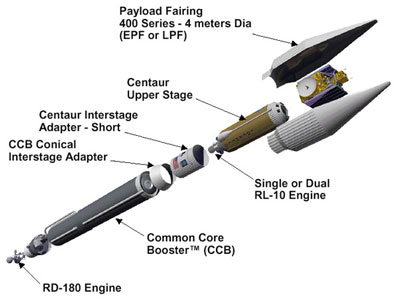
Posted on 01/17/2006 8:36:57 AM PST by Textide
The launch is scheduled from Cape Canaveral, FL at 1:14pm Eastern.
Spaceflightnow.com Mission Status



Launch window closes at 1523 EST.
2:10 pm launch now.
Now launch is set for 2:10 PM, EST.
Thanks.
Look like a half hour delay in launch as they wait for winds to die a bit..
They have a window opening 'til 323 pm ET to launch today,
new launch time is now
~210pm ET
spaceflightnow.com
1838 GMT (1:38 p.m. EST)
NEW LAUNCH TIME! Liftoff has been postponed again. The new target is 2:10 p.m. EST. The further delay allows the team to assess the high-altitude winds and generate a flight profile based on those conditions.
My husband is back in our old PBC stomping grounds, however, about 5 minutes ago, he and my dd had to begin heading south to catch their flight this afternoon. I'm bummed they most likely will now miss seeing it. Waaahhh.
spaceflightnow.com
1842 GMT (1:42 p.m. EST)
A new flight profile load is being created from the upper level wind speed and direction information gathered by weather balloons sent up from the Cape through the countdown.
reschedule to 2:10 EST last check
spaceflightnow.com
1842 GMT (1:42 p.m. EST)
While the upper level wind situation is dealt with, launch managers are still keeping a close eye on the gusty ground winds at the pad. Winds have been flirting with the 33-knot limit for the past couple of hours, and sometimes going above the constraint.
They should be able to see something if there are no clouds.
When I lived in Tampa, I could see the main engines of the shuttle as it gained altitude 80 miles away in broad daylight.
New launch time: 1430 EST.
spaceflightnow.com
1852 GMT (1:52 p.m. EST)
A Lockheed Martin spokesman says the upper level wind issue is actually at an altitude of 800 feet. Attempts to develop a flight profile to withstand the current wind conditions failed the past two tries, he said.
Just got off the phone with him. He's still hoping. He said there are some clouds, but I'm still going to make him stop the car and look north.
He wants to pilot a spacecraft someday, and hasn't let go of that dream. He has sent for the application numerous times, but felt he wasn't ready.
I feel badly for Mrs. Tombaugh & family.
Pluto is merely one of 1/2 million worlds and miniworlds in the Kuiper Belt. We know essentially nothing of the true solar system; the first glimpse of Pluto a few years ago was merely a reflection off one of the nearest of the larger bodies in the whole solar system beyond our home province. These are the steppingstones to the next star.
Antigua tracking offline (mandatory asset) back up in :15 >> new launch time 1930GMT (2:30 eastern)
spaceflightnow.com
1907 GMT (2:07 p.m. EST)
The Atlas team is getting data from the latest weather balloon. The wind information is sent to Lockheed Martin's facilities in Denver for analysis and creation of a new flight profile.
1905 GMT (2:05 p.m. EST)
A problem is now being reported with the Antigua downrange tracking station. That site must be operating for range safety and tracking for the Atlas 5 rocket to be cleared for launch. The Range expects the station to be ready again around 2:20 p.m.
1900 GMT (2:00 p.m. EST)
The upper level winds remain "no go" at this time. The latest flight profile did not find acceptable conditions. Also of concern, the pad winds remain right at the constraint red line limit.
There are no other technical problems being addressed. Countdown clocks continue to hold at T-minus 4 minutes, targeting a possible liftoff time of 2:30 p.m. EST.
1855 GMT (1:55 p.m. EST)
NEW LAUNCH TIME. Liftoff has been pushed back to 2:30 p.m. EST.
Antiqua back on line (??)
here's another Pluto-like object:
2005 FY9 is the third brightest known TNO, after 2003 UB313 and Pluto. Although discovered early in 2005 by USA astronomers M. Brown and co-workers, the discovery wasn't reported until July 29th. The size of 2005 FY9 is 0.7 times that of Pluto approximately. The semi-major axis of its orbit is 46 Astronomical Units (AU, 1 AU=149,597,892 kilometres), the perihelion distance is 39 AU and the inclination of the orbit is 29 deg. These values are typical of the classical TNO family.
spaceref.com
wind profile falling - below maximums now
Disclaimer: Opinions posted on Free Republic are those of the individual posters and do not necessarily represent the opinion of Free Republic or its management. All materials posted herein are protected by copyright law and the exemption for fair use of copyrighted works.